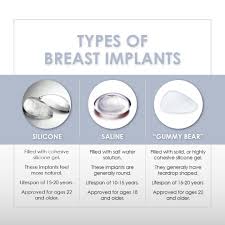Gummy bear implants are a popular choice for those seeking breast augmentation. These teardrop-shaped implants, made from a highly cohesive gel, are often nicknamed “gummy bear” implants due to their shape-retaining gel that resembles the consistency of gummy candy. Compared to traditional saline and silicone implants, gummy bear implants are known for holding their form more effectively over time.
First introduced in the mid-2000s, these implants represent a significant advancement in implant technology, building on over a century of innovations in breast implant design. They may be an ideal option for individuals seeking a natural enhancement in breast volume without the exaggerated contours sometimes associated with other implant types. However, it’s important to note that this procedure isn’t suitable for those who are pregnant or breastfeeding. Additionally, silicone implants, including gummy bear implants, are generally approved only for individuals 22 years or older.
Contents
What are gummy bear implants made of?
Gummy bear implants are made from a unique combination of materials designed to offer both durability and a natural feel. Each implant consists of a silicone outer shell and a thick, cohesive silicone gel filling. Unlike traditional silicone or saline implants, gummy bear implants are specially formulated to retain their teardrop shape even if the outer shell is compromised, thanks to their denser gel composition.
This stability allows gummy bear implants to maintain a natural contour and provide a soft-to-touch feel that many find appealing. By comparison, saline implants, which are also widely used, are filled with a sterile saltwater solution, resulting in a different texture and feel. This enhanced structure of gummy bear implants provides added peace of mind, as they are less likely to lose their shape over time than other implant types.

Are gummy bear implants safe?
After extensive research and evaluations, breast implants, including gummy bear implants, are deemed safe for use. Your healthcare provider will recommend regular screenings to ensure that your implants are properly positioned and have not experienced any ruptures.
Historically, breast implants had a higher likelihood of rupturing and causing related complications. When traditional silicone implants ruptured, the gel could leak into surrounding tissues. However, gummy bear implants are designed with enhanced durability, making them less prone to rupture compared to standard silicone gel and saline implants.
It is important to note that if gummy bear implants do leak, it may be more challenging to identify the issue than with saline implants, which typically deflate noticeably. This emphasizes the need for regular screenings to monitor the condition of your implants. The U.S. Food and Drug Administration (FDA) recommends that women with silicone implants undergo surveillance MRIs three years after implantation and then every two years thereafter to detect any potential problems early on.
Gummy bear implants pros and cons
Gummy bear implants, like other breast augmentation options, are designed to enhance both the shape and size of the breasts. However, one notable disadvantage is that the surgical procedure may require a longer incision, which can elevate the risk of visible scarring. Additionally, it’s important to keep in mind that breast augmentation alone does not correct sagging or droopiness. If addressing breast droop is your main concern, it may be beneficial to consult with a surgeon about the possibility of a breast lift instead. This approach can provide a more comprehensive solution to achieve your desired aesthetic results.

Round versus teardrop-shaped implants
Traditional saline and silicone breast implants generally feature a round shape, which means that even if they shift or rotate over time—a common occurrence—there are typically no significant issues. In contrast, gummy bear implants have a distinctive teardrop shape and are denser compared to their saline and silicone counterparts. This unique design may be ideal for individuals seeking a more natural look with less fullness in the upper breast area, allowing for a gentle droop at the bottom. However, if these implants do rotate, the change will be more noticeable due to their asymmetrical shape.
To minimize the risk of rotation or shifting, gummy bear implants often come with a textured outer shell. This texture enables the surrounding tissue to bond with the implant, effectively anchoring it in place, much like Velcro. Additionally, these textured, shaped implants have been associated with a reduced incidence of capsular contracture—a condition characterized by the abnormal tightening or thickening of tissue around the implant, leading to discomfort, asymmetry, and an unsatisfactory appearance. Capsular contracture is among the most frequently reported complications following breast augmentation, often necessitating further surgical intervention.
Gummy bear implants cost ?
Breast augmentation surgeries, including the use of gummy bear implants, are generally not covered by health insurance and must be financed out-of-pocket. According to the American Society of Plastic Surgeons, the average cost of breast augmentation in 2017 was approximately $3,718. However, opting for gummy bear implants can significantly increase expenses, with estimates ranging from $6,000 to $12,000 depending on various factors such as the surgeon’s experience, the techniques used, and the geographic location of the practice.
In addition to the surgical costs, it’s essential to consider other potential expenses associated with gummy bear breast implants. These may include fees for the surgical facility, anesthesia, and any specialized clothing needed for your recovery. It’s advisable to thoroughly discuss and confirm all associated costs with your provider beforehand to avoid any surprises.
Furthermore, anticipate a recovery period that can extend up to several weeks, during which your body will heal from the procedure. Planning for this time off and any related activities can help ensure a smoother recovery process.

Precautions
While gummy bear implants can deliver impressive results, it’s essential to be aware of the potential risks involved with any surgical procedure. Breast augmentation, in particular, carries various risks, including:
- Bleeding
- Infection
- Changes in nipple sensation
- Pain
- Implant rupture
- Scarring
- Nausea and vomiting from anesthesia
- Wrinkling of breast tissue
Additionally, some patients have reported serious side effects, such as severe nausea, back pain, and unintended weight loss.
In 2011, the FDA identified a correlation between breast implants and a rare form of cancer known as breast implant-associated anaplastic large cell lymphoma (BIA-ALCL). While the precise causes of this condition remain unclear, there appears to be a higher incidence associated with textured implants compared to smooth ones.
It’s also crucial to understand that the results of breast implants are not permanent. Beyond the risk of rupture, the American Society of Plastic Surgeons advises that breast implants are not designed to last a lifetime. On average, women may need to replace or remove their implants after about 10 years. Prolonged use increases the likelihood of experiencing side effects.
Maintaining a stable body weight before undergoing surgery is recommended, as significant fluctuations can alter the appearance of your breasts. The teardrop shape of gummy bear implants offers a more natural look compared to the roundness of traditional implants. However, they do pose a risk of rotation, which can lead to an irregular breast shape until corrective surgery is performed to reposition or replace the implants.
Key Takeaways
Gummy bear implants are often regarded as more durable and potentially longer-lasting compared to other options, such as traditional silicone or saline implants. However, this increased durability typically comes with a higher price tag. It’s essential to recognize that gummy bear implants are not without their risks, making it crucial to select a skilled and reputable surgeon for the procedure. Ensuring you have the right professional by your side can significantly impact your results and overall satisfaction with your breast augmentation journey.








